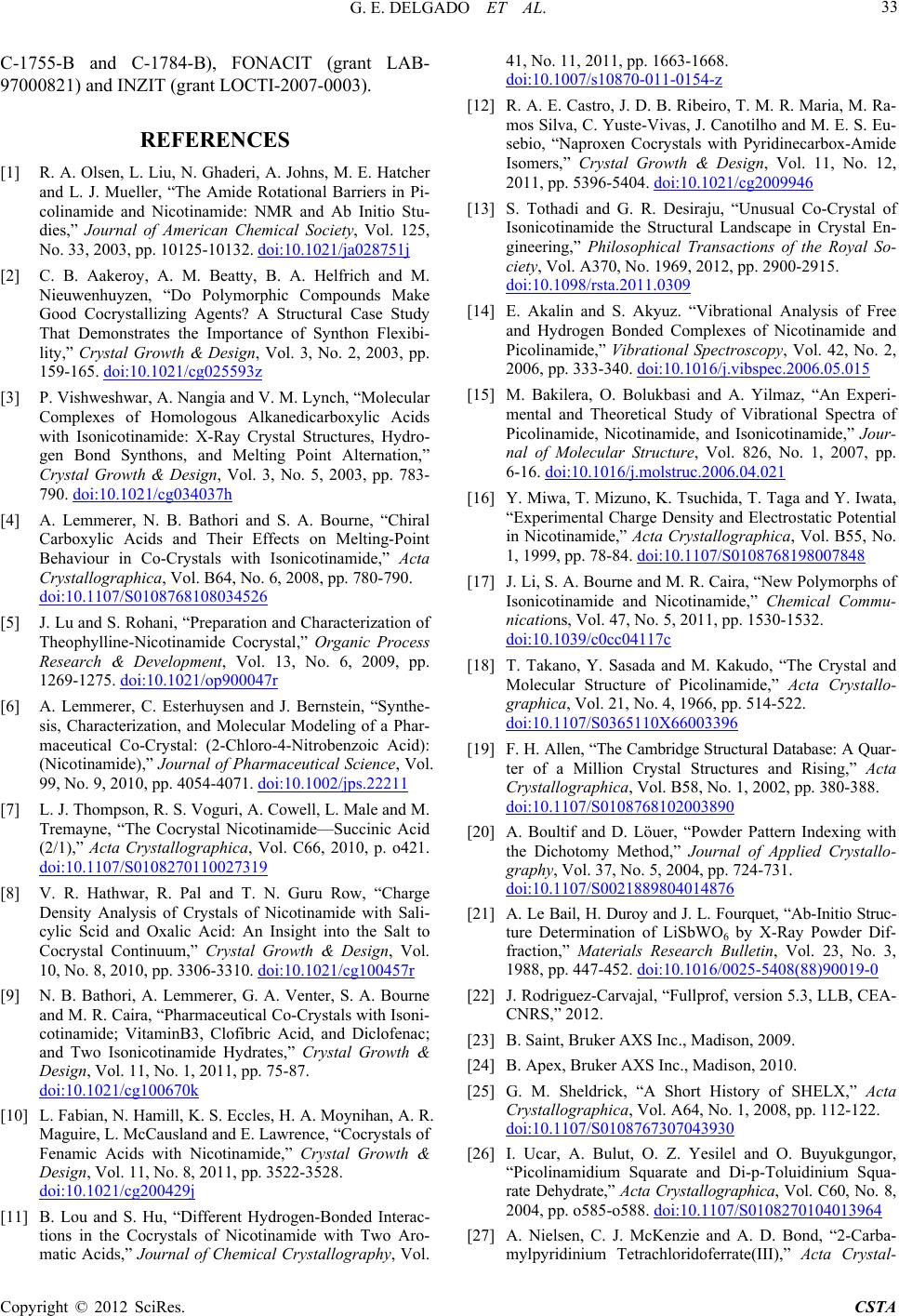
G. E. DELGADO ET AL. 33
C-1755-B and C-1784-B), FONACIT (grant LAB-
97000821) and INZIT (grant LOCTI-2007-0003).
REFERENCES
[1] R. A. Olsen, L. Liu, N. Ghaderi, A. Johns, M. E. Hatcher
and L. J. Mueller, “The Amide Rotational Barriers in Pi-
colinamide and Nicotinamide: NMR and Ab Initio Stu-
dies,” Journal of American Chemical Society, Vol. 125,
No. 33, 2003, pp. 10125-10132. doi:10.1021/ja028751j
[2] C. B. Aakeroy, A. M. Beatty, B. A. Helfrich and M.
Nieuwenhuyzen, “Do Polymorphic Compounds Make
Good Cocrystallizing Agents? A Structural Case Study
That Demonstrates the Importance of Synthon Flexibi-
lity,” Crystal Growth & Design, Vol. 3, No. 2, 2003, pp.
159-165. doi:10.1021/cg025593z
[3] P. Vishweshwar, A. Nangia and V. M. Lynch, “Molecular
Complexes of Homologous Alkanedicarboxylic Acids
with Isonicotinamide: X-Ray Crystal Structures, Hydro-
gen Bond Synthons, and Melting Point Alternation,”
Crystal Growth & Design, Vol. 3, No. 5, 2003, pp. 783-
790. doi:10.1021/cg034037h
[4] A. Lemmerer, N. B. Bathori and S. A. Bourne, “Chiral
Carboxylic Acids and Their Effects on Melting-Point
Behaviour in Co-Crystals with Isonicotinamide,” Acta
Crystallographica, Vol. B64, No. 6, 2008, pp. 780-790.
doi:10.1107/S0108768108034526
[5] J. Lu and S. Rohani, “Preparation and Characterization of
Theophylline-Nicotinamide Cocrystal,” Organic Process
Research & Development, Vol. 13, No. 6, 2009, pp.
1269-1275. doi:10.1021/op900047r
[6] A. Lemmerer, C. Esterhuysen and J. Bernstein, “Synthe-
sis, Characterization, and Molecular Modeling of a Phar-
maceutical Co-Crystal: (2-Chloro-4-Nitrobenzoic Acid):
(Nicotinamide),” Journal of Pharmaceutical Science, Vol.
99, No. 9, 2010, pp. 4054-4071. doi:10.1002/jps.22211
[7] L. J. Thompson, R. S. Voguri, A. Cowell, L. Male and M.
Tremayne, “The Cocrystal Nicotinamide—Succinic Acid
(2/1),” Acta Crystallographica, Vol. C66, 2010, p. o421.
doi:10.1107/S0108270110027319
[8] V. R. Hathwar, R. Pal and T. N. Guru Row, “Charge
Density Analysis of Crystals of Nicotinamide with Sali-
cylic Scid and Oxalic Acid: An Insight into the Salt to
Cocrystal Continuum,” Crystal Growth & Design, Vol.
10, No. 8, 2010, pp. 3306-3310. doi:10.1021/cg100457r
[9] N. B. Bathori, A. Lemmerer, G. A. Venter, S. A. Bourne
and M. R. Caira, “Pharmaceutical Co-Crystals with Isoni-
cotinamide; VitaminB3, Clofibric Acid, and Diclofenac;
and Two Isonicotinamide Hydrates,” Crystal Growth &
Design, Vol. 11, No. 1, 2011, pp. 75-87.
doi:10.1021/cg100670k
[10] L. Fabian, N. Hamill, K. S. Eccles, H. A. Moynihan, A. R.
Maguire, L. McCausland and E. Lawrence, “Cocrystals of
Fenamic Acids with Nicotinamide,” Crystal Growth &
Design, Vol. 11, No. 8, 2011, pp. 3522-3528.
doi:10.1021/cg200429j
[11] B. Lou and S. Hu, “Different Hydrogen-Bonded Interac-
tions in the Cocrystals of Nicotinamide with Two Aro-
matic Acids,” Journal of Chemical Crystallography, Vol.
41, No. 11, 2011, pp. 1663-1668.
doi:10.1007/s10870-011-0154-z
[12] R. A. E. Castro, J. D. B. Ribeiro, T. M. R. Maria, M. Ra-
mos Silva, C. Yuste-Vivas, J. Canotilho and M. E. S. Eu-
sebio, “Naproxen Cocrystals with Pyridinecarbox-Amide
Isomers,” Crystal Growth & Design, Vol. 11, No. 12,
2011, pp. 5396-5404. doi:10.1021/cg2009946
[13] S. Tothadi and G. R. Desiraju, “Unusual Co-Crystal of
Isonicotinamide the Structural Landscape in Crystal En-
gineering,” Philosophical Transactions of the Royal So-
ciety, Vol. A370, No. 1969, 2012, pp. 2900-2915.
doi:10.1098/rsta.2011.0309
[14] E. Akalin and S. Akyuz. “Vibrational Analysis of Free
and Hydrogen Bonded Complexes of Nicotinamide and
Picolinamide,” Vibrational Spectroscopy, Vol. 42, No. 2,
2006, pp. 333-340. doi:10.1016/j.vibspec.2006.05.015
[15] M. Bakilera, O. Bolukbasi and A. Yilmaz, “An Experi-
mental and Theoretical Study of Vibrational Spectra of
Picolinamide, Nicotinamide, and Isonicotinamide,” Jour-
nal of Molecular Structure, Vol. 826, No. 1, 2007, pp.
6-16. doi:10.1016/j.molstruc.2006.04.021
[16] Y. Miwa, T. Mizuno, K. Tsuchida, T. Taga and Y. Iwata,
“Experimental Charge Density and Electrostatic Potential
in Nicotinamide,” Acta Crystallographica, Vol. B55, No.
1, 1999, pp. 78-84. doi:10.1107/S0108768198007848
[17] J. Li, S. A. Bourne and M. R. Caira, “New Polymorphs of
Isonicotinamide and Nicotinamide,” Chemical Commu-
nications, Vol. 47, No. 5, 2011, pp. 1530-1532.
doi:10.1039/c0cc04117c
[18] T. Takano, Y. Sasada and M. Kakudo, “The Crystal and
Molecular Structure of Picolinamide,” Acta Crystallo-
graphica, Vol. 21, No. 4, 1966, pp. 514-522.
doi:10.1107/S0365110X66003396
[19] F. H. Allen, “The Cambridge Structural Database: A Quar-
ter of a Million Crystal Structures and Rising,” Acta
Crystallographica, Vol. B58, No. 1, 2002, pp. 380-388.
doi:10.1107/S0108768102003890
[20] A. Boultif and D. Löuer, “Powder Pattern Indexing with
the Dichotomy Method,” Journal of Applied Crystallo-
graphy, Vol. 37, No. 5, 2004, pp. 724-731.
doi:10.1107/S0021889804014876
[21] A. Le Bail, H. Duroy and J. L. Fourquet, “Ab-Initio Struc-
ture Determination of LiSbWO6 by X-Ray Powder Dif-
fraction,” Materials Research Bulletin, Vol. 23, No. 3,
1988, pp. 447-452. doi:10.1016/0025-5408(88)90019-0
[22] J. Rodriguez-Carvajal, “Fullprof, version 5.3, LLB, CEA-
CNRS,” 2012.
[23] B. Saint, Bruker AXS Inc., Madison, 2009.
[24] B. Apex, Bruker AXS Inc., Madison, 2010.
[25] G. M. Sheldrick, “A Short History of SHELX,” Acta
Crystallographica, Vol. A64, No. 1, 2008, pp. 112-122.
doi:10.1107/S0108767307043930
[26] I. Ucar, A. Bulut, O. Z. Yesilel and O. Buyukgungor,
“Picolinamidium Squarate and Di-p-Toluidinium Squa-
rate Dehydrate,” Acta Crystallographica, Vol. C60, No. 8,
2004, pp. o585-o588. doi:10.1107/S0108270104013964
[27] A. Nielsen, C. J. McKenzie and A. D. Bond, “2-Carba-
mylpyridinium Tetrachloridoferrate(III),” Acta Crystal-
Copyright © 2012 SciRes. CSTA